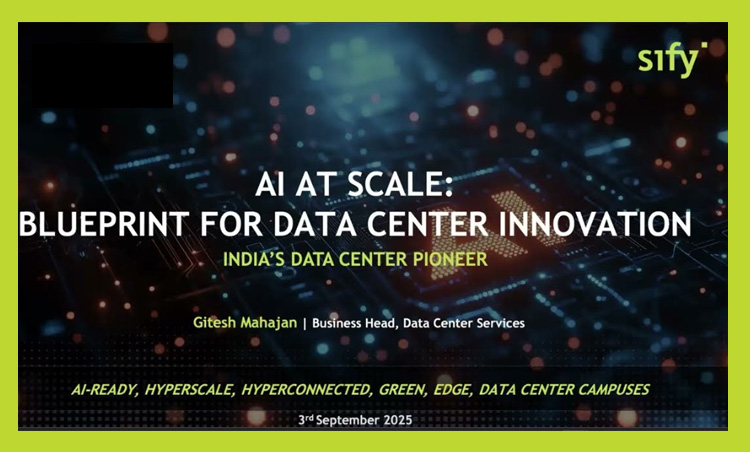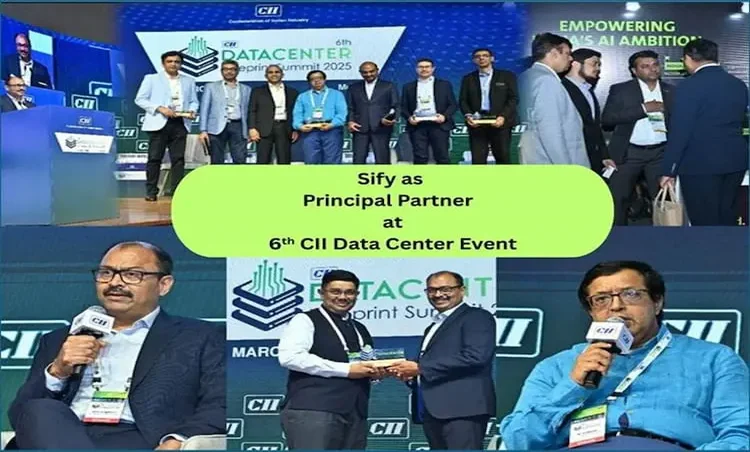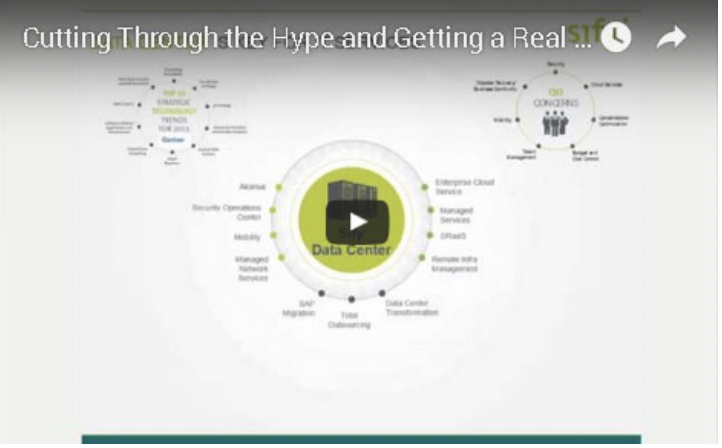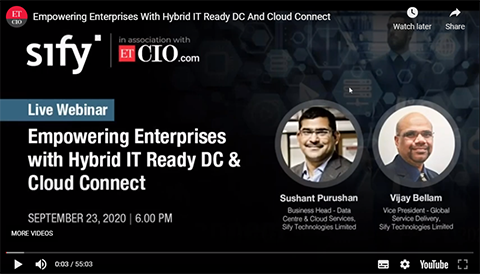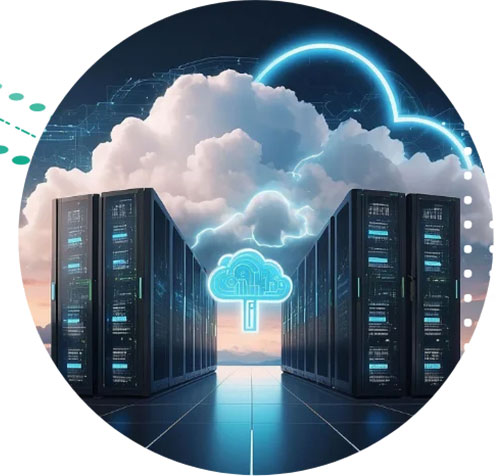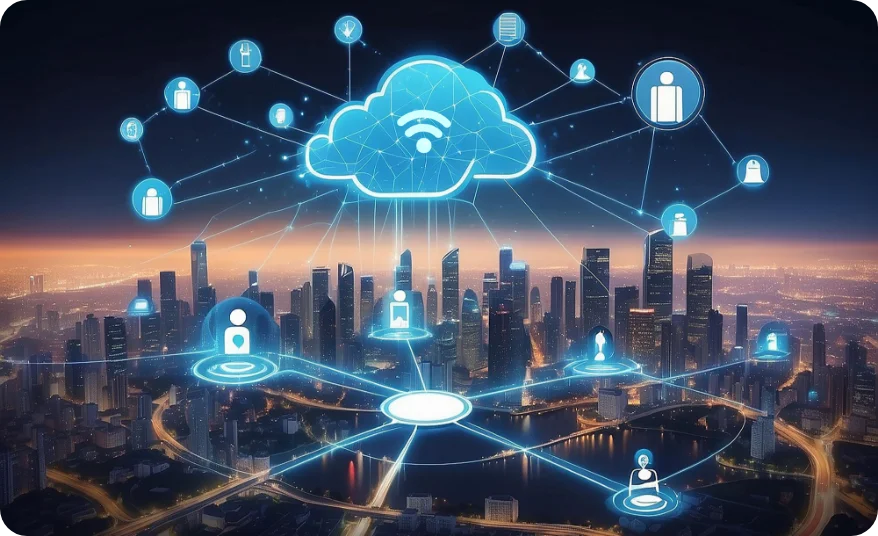Data Center Security and Compliance Gaps That Put AI Workloads at Risk
As enterprises scale AI, data centers must host GPU clusters, high-density compute racks, and massive training datasets. These environments behave very differently from traditional IT systems, which were predictable, centralized, and easier to secure.
AI at Scale: Blueprint for Data Center Innovation in BFSI
SPEAKERS:Gitesh Mahajan – Head, Data Center Business, Sify Technologies Limited Sojan Joy – Vice President, Product and Solutions Head, Data Center Services, Sify Technologies Limited
Abhay Johorey- Managing Director, Protiviti India
Anish Koshy- VP – Information and Cyber Security Risk Officer, Standard Chartered GBS
Arjun Bikas Dutta, CCO, HDB Financial Services Ltd
Building Sustainable Digital Foundations for Datacenters
Sify participated in the 6th CII Datacenter Blueprint Summit 2025 Event in Mumbai themed “Building Sustainable Digital Foundations for Datacenters” as Principal Partner on Thursday, 20th March 2025.
The event was attended by senior government officials, regulatory authorities and industry stalwarts to engage in a dialog for creating cohesive action plans for the inclusive growth of the sector.
The event was attended by 300+ delegates. Govt dignitaries marked their presence at the event like :
- Dr P Anbalagan, IAS – Secretary Industries, Government of Maharashtra
- P Velrasu, IAS – Chief Executive Officer – Maharashtra Industrial Development Corporation (MIDC)
- Kaustubh Dhavse – Joint Secretary & Officer on Special Duty to Hon’ble Chief Minister of Maharashtra, Government of Maharashtra
Sify Speakers
- Inauguration session and Panel Discussion by Sharad Agarwal on “Changing Datacenter Landscape in India and Worldwide – Challenges and Opportunities”.
- A Panel Discussion by Girish Dhavale on “Unfolding AI Landscape & Opportunities for Datacenter Service Providers”
Key discussion points include:
- India’s Data Center industry is expanding rapidly, driven next-gen high density workloads, demanding sustainability and innovation.
- Showcased Sify’s Largest AI-Ready Data Center Campus, Mumbai 03 is Future ready and capable to cater growing customer demands of a seamless secure and scalable Data Center
- How GPU-as-a-Service and AI-driven workload regulation are transforming Data Center operations
- How Sify delivers sustainable cooling solutions, including liquid cooling, to enhance energy efficiency, while integrating AI into cloud infrastructure to optimize performance and scalability for customers.
Data Center Automation – Exploring Opportunities and Addressing Challenges
In the grand tapestry of India’s digital journey, data center automation is a defining thread that weaves excellence, resilience, and growth into the very fabric of the nation’s IT landscape. The amalgamation of innovation and automation empowers data center companies to transform operations, elevate security, and unlock new levels of efficiency. As the scale and complexity of data management continue to escalate, the role of automation in data centers has emerged as a transformative force. From provisioning and configuration management to monitoring and security, automation is the catalyst behind operational efficiency, reduced human intervention, and remarkable precision.
Data center automation involves the use of advanced technologies like AI/ML and robust software to streamline & orchestrate various data center processes. This automation enables data centers to operate tasks that were previously time-consuming, error-prone, and labour-intensive. These tasks can now be automated, leading to optimized resource utilization and improved overall performance. With the right approach, data center automation can revolutionize the digital IT landscape, enabling businesses to stay agile, competitive, and future-ready.
India’s Data Center Landscape: A catalyst for Innovation
India is becoming the preferred data center destination for enterprises and hyperscalers. Currently, there are 138 operational data centers in India, utilizing 737 MW power. Over the next 3-4 years, an additional 50 data centers are expected to be established, resulting in a power demand of 1050 MW. Indian cities like Chennai, Hyderabad, Bengaluru, Mumbai, Pune, Noida, and Kolkata are emerging as data center hubs, hosting a myriad of providers catering to diverse industries. Several leading companies leverage automation techniques to deliver seamless and reliable solutions to their clients. The adoption of automation has enabled them to offer cost-effective services, rapid deployment, and robust security measures.
Important Role of Virtualization
Virtualization forms the crux of data center automation, particularly in cloud computing environments. By abstracting hardware resources and creating virtual machines (VMs), data center administrators can deploy and manage applications more efficiently. Virtualization allows for dynamic allocation of resources, on-demand scalability, and workload migration across servers. This flexibility streamlines automation processes and optimizes resource usage. It enables data centers to adapt and scale rapidly according to their requirements.
Benefits of Data Center Automation
Data center automation presents a world of opportunities for businesses in India and around the globe. The opportunities presented by automation are vast, ranging from operational efficiency to enhanced resource utilization. Data centers must automate to experience the following benefits:
- Enhanced Efficiency: Automation propels data centers into an era of unparalleled efficiency by eliminating manual intervention. Time-consuming routine tasks, once automated, can be executed with precision, freeing up skilled personnel to focus on strategic endeavours. By automating resource allocation and workload management, data centers can achieve optimal utilization of computing power, storage, network resources, and automate incident response. This efficiency translates into reduced downtime, optimized power consumption, better hardware utilization, improved operational efficiency, cost savings, better scalability, and a greener footprint.
- Faster Deployment & Flexibility: Automation expedites the deployment of applications and services in a data center. With automation’s ability to swiftly allocate resources on demand, data centers become more agile and responsive to changing workloads. This scalability ensures optimal performance, even during traffic spikes or resource-intensive tasks. Automated Data Centers embody flexibility by seamlessly adapting to evolving business needs. Through intelligent automation, these facilities can swiftly deploy new services or applications as demand fluctuates. This adaptability ensures that businesses can respond to changing market conditions and customer demands with agility, without the constraints of static infrastructure.
- Enhanced Security Posture: Automated security protocols keep a constant vigil on data center environments. Threat detection and accelerated incident response help prevent cyber threats and potential breaches. Automated security measures aid in responding promptly to security incidents. This proactive approach enhances data center security, protecting sensitive data and critical systems.
- Rich Data Insights and Analytics: Leveraging the power of automation and advanced monitoring systems, the data centers constantly collect more and more data on business performance, resource utilization and system health. The data analytics provides businesses with valuable insights into their IT infrastructure. This insight empowers organizations to make data-driven decisions, optimize resource allocation, predict maintenance needs, and improve overall efficiency.
- Cost Savings: Automation led data centers help save costs through energy efficiency, resource management, predictive analytics & maintenance, scalability, labor efficiency, error reduction, location optimization, integration, and compliance management These cost-saving benefits make automation a strong investment for businesses looking to optimize their IT systems.
Challenges in Data Center Automation
While the benefits of data center automation are compelling, embracing automation comes with its own set of challenges. Many data centers consist of heterogeneous systems and technologies, making it difficult to integrate new automation tools seamlessly. Here are a few challenges that data centers may face while embracing automation:
- Skills Gap: Introducing automation into existing data center infrastructures demands careful planning and integration. Besides, adopting automation requires skilled personnel who can manage and maintain the automated processes. Data center staff may need to upskill or reskill to effectively leverage these automation tools. They must evolve from playing traditional roles to becoming adept orchestrators of automated workflows and processes.
- Security Concerns: As automation reduces manual intervention, robust security measures become paramount. Safeguarding against unauthorized access and potential vulnerabilities is imperative. Data centers must keep an eye for unauthorized access to automation systems or potential misconfigurations, which could lead to severe data breaches and service disruptions..
- Large Initial Investment: The initial capital investment required to implement automation tools and technologies can be significantly high. Smaller data center companies in India may find it challenging to invest in these technologies, limiting their ability to compete effectively. While the long-term benefits are substantial, data center companies must carefully assess the need for capital investment against the potential gains they offer.
- Regulatory Non-compliance: Automation may raise concerns about non-compliance with industry standards and data protection regulations. Hence, data center companies must ensure their automated processes comply with the industry standards and regulations including Personal Data Protection Bill (PDPB), ISO 27001, Payment Card Industry Data Security Standard (PCI DSS), Telecom Regulatory Authority of India (TRAI), ISO 14001, and more.
Transforming Data Centers With Sify Technologies
Sify Technologies has been a pioneer in the India data center services market, serving enterprises for more than two decades. We have been delivering value to our customers by enabling them to achieve their digital transformation goals, powered by intelligent data center automation. Sify data centers provide automation benefits such as better visibility into the data center operations, while ensuring optimum utilization of resource capacity. Paving the way for innovation and growth, we are not only transforming data center operations but also contributing to building India’s tech landscape.
The integration of AI/ML-based predictions plays a crucial role in managing availability, performance, cost, and capacity. Currently, Sify data centers commits:
- 8-10% savings on PUE
- Improving equipment time by 20%
- Up to 300 person hour savings in a month
- 20% reduced MTBF, 10% improved MTTR, and 10% reduction in unplanned/possible downtime
- reduction in customer penalties by maintaining SLAs
- 10% reduction in operating cost
Conclusion
In conclusion, the field of data center automation offers countless opportunities for organizations to increase efficiency, scalability, and reliability in their business. Adoption of automation technology can enable routine tasks simplify, reduce human error, and free up IT staff for more strategic efforts. However, it is important to acknowledge and address challenges such as security concerns, skills gaps and the need for better planning and management. With a strategic thinking approach, organizations can unlock the full potential of data center automation, paving the way for faster and more agile digital processes in a data-driven world.
Accelerate your digital transformation journey with a digital-ready IT infrastructure powered by Sify. Learn more about how Sify can transform your organization by becoming your digital infrastructure partner.
The Emergence of Hybrid Cloud: What It Means for Data Centers
Managing a hybrid cloud environment demands a holistic approach. In the rapidly evolving landscape of modern computing, data centers are burdened with the challenge to meet the ever-growing demands of enterprises, while remaining agile, cost-effective, and secure. One solution that has helped data centers immensely is the adoption of a hybrid cloud model, which is a computing environment that combines both public cloud capabilities and a private cloud infrastructure. By combining the strengths of public and private cloud environments, a hybrid cloud architecture offers enterprises a transformative approach to data center management.
The foundation of a successful hybrid cloud implementation lies in establishing a robust infrastructure that seamlessly connects private and public cloud resources. Data centers need to manage data movement, synchronization, and replication between their on-premises infrastructure and public cloud providers. This requires robust data management and integration capabilities within the data center.
Enterprises must invest in modernizing their networking and storage infrastructure, employing software-defined networking (SDN) and software-defined storage (SDS) technologies to enable efficient data movement and workload mobility across environments.
Potential of a hybrid cloud for data centers
Hybrid cloud networking is crucial for establishing seamless connectivity between data centers and public cloud providers. Implementing high-speed, low-latency connections, such as virtual private networks (VPNs) or dedicated links, ensures reliable and secure data transfer. Data centers must focus on network optimization, traffic routing, and intelligent load balancing to maximize performance in hybrid environments.
Enterprises must implement a unified hybrid cloud management platform which is capable of providing visibility, control, and automation across diverse cloud resources. This central management framework streamlines operations, ensuring consistent policies, security controls, and compliance across both – private and public clouds.
Working with a hybrid cloud services provider
A hybrid cloud services provider acts as a strategic partner that empowers enterprises to seamlessly integrate public and private cloud resources. By partnering with a reliable provider, data centers gain access to a comprehensive suite of tools, technologies, and expertise required to architect and manage hybrid cloud environments effectively.
Enterprises benefit from cloud adjacency or the close proximity of their data centers to hybrid cloud service providers’ points of presence or regional hubs. This arrangement offers several benefits, such as reduced latency, improved data transfer speeds, lower network costs, and better interconnectivity.
The provider of a hybrid cloud architecture offers unparalleled flexibility and scalability, allowing enterprises to optimize resource allocation, by leveraging private infrastructure for sensitive workloads, and tapping into the vast compute power of public clouds for bursting or scaling requirements. This dynamic approach enhances operational efficiency and cost-effectiveness, accommodating evolving business needs.
Adopting advanced technologies to automate and streamline multiple data center processes helps increase efficiency and reduce costs. Data center architects need to design data center infrastructures that can seamlessly integrate with public cloud providers, enabling the efficient movement of workloads between on-premise data centers and the public cloud. By adopting a hybrid cloud model, data centers can easily track and monitor their networks, applications, and user behaviour.
Benefits of adopting a hybrid cloud
The emergence of the hybrid cloud has significant implications for data centers. Here’s an overview of what hybrid clouds have in store for data centers:
- Flexibility and Scalability: A hybrid cloud enables enterprises to scale their computing resources up or down based on demand. It enables data centers to accommodate the dynamic nature of workloads that may span across both private and public cloud environments. During peak periods or when facing sudden spikes in workload, the public cloud can provide additional capacity, ensuring smooth operations without compromising performance.
- Connectivity and Network Setup: Hybrid cloud deployments offer strong connectivity between a private data center and a public cloud provider. They ensure reliable and low-latency connectivity. Hybrid cloud connectivity extends beyond the boundaries of the data center, encompassing various cloud services and endpoints. To fully harness the benefits of hybrid cloud, data centers should prioritize interconnectivity between on-premises infrastructure, public clouds, and other external services.
- Data Center Modernization: To support hybrid cloud environments, data centers may need to modernize their infrastructure, adopting technologies such as software-defined networking (SDN), virtualization, and automation through AI/ML. These upgrades allow for better integration and management of workloads across between colocation, private cloud, and public cloud environment. By harnessing real-time monitoring, data visualization, and predictive analytics, organizations can optimize data center performance, enhance reliability, and proactively address potential issues. The benefits of data center monitoring analytics extend to improved resource utilization, reduced downtime, enhanced security, and better decision-making.
- Security and Compliance: Data centers play a critical role in ensuring the security and compliance of data and workloads in a hybrid cloud environment. A robust hybrid cloud management platform offers a unified view of resources, facilitates workload placement decisions, automates provisioning and scaling, enforces security policies, and enables seamless workload migration between clouds in a secure manner. Enterprises need to implement robust security measures, access controls, encryption, and monitoring systems to protect their data in the hybrid cloud. Here are some common security practices that data centers must embrace:
- Limiting physical access to authorized personnel through key cards, biometric authorization or other access control mechanisms.
- Implementing perimeter security such as fencing, gates, and security patrols.
- Deploying firewalls to control and monitor incoming and outgoing network traffic.
- Installing Intrusion Detection/Prevention Systems to detect and prevent suspicious activities and potential attacks.
- Encrypting sensitive data both at rest and during transmission using strong encryption algorithms (e.g., AES, RSA) to protect against unauthorized access.
- Implementing SSL/TLS protocols to secure data transmission over networks and web applications.
- Conducting regular vulnerability assessments to identify potential weaknesses and vulnerabilities in the data center infrastructure and applications.
- Establishing a well-defined incident response plan to handle security breaches and incidents effectively and minimize their impact.
- Data Placement and Workload Optimization: Enterprises are able to make intelligent decisions about where to place their workloads and data based on factors like performance, cost, compliance requirements, and data sovereignty regulations. This involves optimizing workload distribution between the private and public components of the hybrid environment. Doing this prevents bottlenecks and minimizes downtime. By analyzing sensor data and historical trends, data center service providers can improve equipment uptime by up to 20% with advanced predictive analytics.
- Data Backup for Disaster Recovery and Business Continuity: Implementing a robust data backup strategy helps ensure data integrity and availability in the event of data loss or corruption. Data centers must also develop comprehensive disaster recovery plans to recover critical systems and data in case of a disaster or major outage.
- Multi-cloud Strategy: A multi-cloud strategy empowers data centers with greater flexibility, resilience, and cost optimization. By diversifying their cloud resources across multiple providers, data centers can take advantage of the strengths of different vendors, optimize performance, and maintain operational efficiency even in the face of disruptions or changes in the cloud landscape. Additionally, a multi-cloud approach enables data centers to adapt to evolving business needs while maintaining control over their infrastructure and data.
Unlock the benefits of the hybrid cloud for your enterprise with Sify
With the right hybrid cloud services provider, robust infrastructure, streamlined connectivity, and effective management platform, data centers can unlock the full potential of hybrid cloud and position themselves at the forefront of digital transformation. A hybrid cloud can not only future-proof data centers but also enable enterprises to thrive in an increasingly competitive and dynamic business landscape.
At Sify Technologies, we understand the importance of hybrid cloud for data centers and how it revolutionizes the way enterprises utilize and leverage cloud services. We empower data centers to optimize resource utilization, improve operational efficiency, and enhance overall productivity and profitability.
We also help data centers to adapt to evolving business needs, optimize resource utilization, and deliver exceptional performance. We have invested in more than 200 MW of green power because we are committed to reducing our global carbon footprint by promoting the usage of sustainable energy. Our green data centers are designed to help enterprises reduce energy costs by up to 40%.
A pioneer in the industry, Sify Technologies has been consistently helping enterprises with bespoke hybrid cloud management and data center services for several years. Our customers work with us because we:
- Conceptualize, architect and implement the most efficient hybrid cloud
- Provide a consistent user experience across clouds
- Automate the discovery and tagging of critical resources across cloud environments
- Offer AI-driven workload optimization for enhanced app performance
- Ensure detailed tracking of billing data
Learn how your enterprise can benefit from the Sify Data Center experience.
How Hyperscale Data Centers are reshaping India’s IT
In today’s times, a common question arises while discussing technology: what is the difference between Data Centers and Hyperscale Data Centers?
The answer: Data Centers are like hotels – the spaces are shared with multiple guests, whereas, in the case of Hyperscale Data Centers, the entire building/campus are dedicated to a single customer.
Companies like Amazon, Google, Microsoft, Facebook, and OTTs, which have millions and millions of end-users, have infused their services into our day-to-day life to cater to our personal and professional needs. Data centers are the backbone of this digital world.
This is where Hyperscale Data Centers come into play and provide seamless experiences to such massive end-users.
The term Hyperscale means the ability of an infrastructure to scale up when the demand for the service increases. The infrastructure comprises of computers, storage, memory, networks etc. The maintenance of such infrastructure is not an easy task. Constant monitoring of the machines, the server hall temperature and humidity control check and other critical parameters are monitored 24×7 by the Building Management System (BMS).
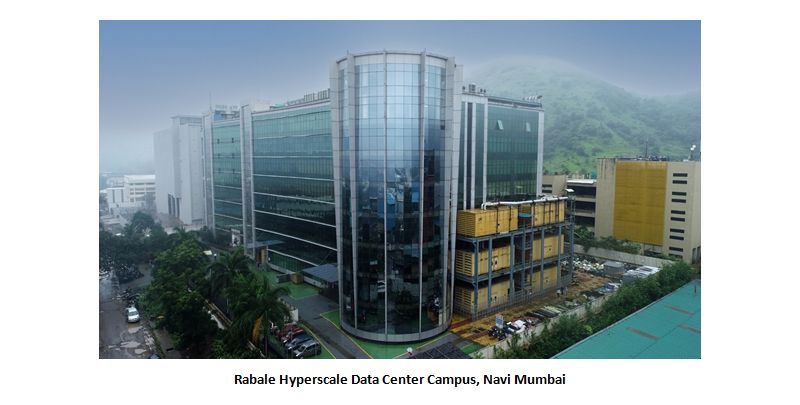
Data Centers are important because everyone uses data. It is safe to say that perhaps everyone, from individual users like you and me to multinationals, used the services offered by data centers at some point in their lives. Whether you’re sending emails, shopping online, playing video games, or casually browsing social media, every byte of your online storage is stored in your data center. As remote work quickly becomes the new standard, the need for data centers is even greater. The cloud data center is rapidly becoming the preferred mode of data storage for medium and large enterprises. This is because it is much more secure than using traditional hardware devices to store information. Cloud data centers provide a high degree of security protection, such as firewalls and back-up components, in the event of a security breach. The COVID-19 pandemic paved the way for the work-from-home culture, and the global internet traffic increased by 40% in 2020
Also, the rise of new technologies like the Internet of Things (IoT), Artificial Intelligence (AI), Machine Learning (ML), 5G, Augmented Reality (AR), Virtual Reality (VR) and Blockchain caused an explosion of data generation and an increased demand for storage capacities.
Cloud infrastructure has helped businesses and governments with solutions to respond to the pandemic. To cater to such needs, the demand for cloud data center facilities has increased. A heavy infrastructure with a lot of power is needed to cater to such needs.
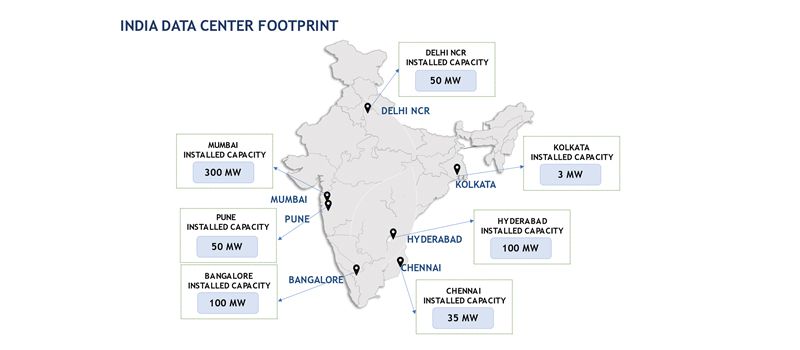
Data Centers have quite a negative impact on the environment, because of the large consumption of power sources and has 2% of the global contribution of greenhouse gas emissions. To reduce these carbon footprints and work towards a sustainable environment, many data center providers globally have started using power from renewable energy sources like solar and wind energy through Power Purchase Agreements (PPA). The Data Center power consumption can be lowered by regularly updating their systems with new technologies and regular maintenance of the existing infrastructure.
The Indian market will see multifold growth in the Data Center industry due to ease of doing business in the country and thanks to the attractive subsidiaries provided by the state governments, huge investments are committed in the next four years.
Interesting facts about Data Center:
- A large Data Center uses the electricity equivalent to a small Indian town.
- The largest data center in the world is of 10.7 million sq.ft. in China, approximately 1.5 times of the Pentagon building in USA.
- Data Centers will nearly consume 2% of the world’s electricity by 2030. Hence, the Green Data Center initiatives are taken up by various organizations.
How Data Center forms the epicenter of IT infrastructure
SPEAKERS:
Kirtikar Ojha, Business Head – Data Center Services, Sify Technologies
DATE:
Wednesday, December 02, 2015
DESCRIPTION:
Businesses are becoming more and more Information-driven. As data becomes the most important organizational asset; Data Centers need to be reliable, safe, optimized, efficient and manageable and de-risked, because any risk to data would have a seismic impact on the entire business. How to formulate a comprehensive Data Center strategy? Find out in this webinar
Empowering Enterprises with Hybrid IT Ready DC & Cloud Connect
SPEAKERS:
Sushant Purushan, Business Head – Data Centre & Cloud Services, Sify Technologies Limited
Vijay Bellam, Vice President – Global Service Delivery, Sify Technologies Limited
DATE:
September 23, 2020 | 6.00 PM
DESCRIPTION:
As cloud computing becomes an integral part of IT, it exerts a greater influence on enterprises, starting from infrastructure and business strategy to design and location. Selection of data center technologies and providers to complement public clouds have become critical to retain agility, flexibility, scalability and choices.
For hybrid cloud deployments, cloud-adjacent or near-cloud data centers with high-performance, secure cloud interconnects are vital for various application configurations, resiliency, availability and to meet expected SLAs. It is important in this context of having a data center and cloud interconnect with minimum latency and flexible bandwidth.
A professionally run data center with all the above capabilities offers peace of mind and stability by way of robust security and compliance to a business during these troubled times and, thereby, allowing them to focus on their transformational objectives.
In an insightful web session, organized by ETCIO.com and Sify, industry experts will throw more light on how enterprises can leverage hybrid IT-ready data centers and cloud interconnect for business growth.
Future of Data Center: Architectural Advances
Data is growing at an exponential rate in the modern borderless world. Over 2.5 Quintilian bytes of data is generated every day across the globe. India alone is set to produce 2.3 million petabytes of digital data by the year 2020, and it is growing at a rate that’s much faster than the world average. Many enterprises are also exploring online data backup in the cloud further fueling this data explosion.
This data explosion increases the demand for storage capacities that are served by Data Centers. In just two decades, Data Centers have scaled up from the size of a room to the size of a commercial tower giving way to accommodate this increased storage need. Besides storage, modern Data Centers are also sprucing up to handle more services. They are more connected than ever and can meet the needs of the contemporary business world. New solutions have emerged around Data Center architecture that can bring competitive advantages to users through more optimized performance. Data Centers have now become critical components of a modern IT infrastructure.
In India, we see emerging businesses growing at a fast pace, with cloud computing technologies and cloud warehouses taking the lead to store enormous amounts of digital data. At the beginning of the 21st century, most organizations in India had captive Data Centers that were self-managed. With advances introduced in cloud technologies and specialized players adding more capabilities, the self-managed option was replaced by the outsourcing model. Increase in the users, economic growth of the country, and cost advantages of cloud-based Data Centers are some of the trends driving adoption of a cloud-based architecture. Captive Data Centers are expensive to accommodate and challenging to scale. However, cloud-based Data Center architectures are more flexible.
Many new technologies, services, and facilities that were premium and rare earlier are now part of standard offerings in modern Data Centers. These services are reshaping the way businesses operate today.
Another trend to note is the emergence of Modular 4th generation Data Centers. These Data Centers comprise modular units that help in quickly scaling up the infrastructure. In addition to the components in the racks being modular, the building itself could be modular. For instance, some Data Centers are built in shipping containers. Scaling up means adding more shipping containers with Data Center units.
Resolving the Challenges
Many challenges of the past have now been resolved with architectural advances in the Data Center space. For instance, Pod architecture for SaaS assigns a set of machines to a specific job or customer for all of its required tasks. To create redundancies for power and cooling in a Data Center, a lot of assembling needs to be done which can incur a cost. You may also need to construct additional racks. However, POD comes with frames that are free standing and compatible with most equipment so it can be used for all needs including power, cooling, and cabling. So, your need for construction within the Data Center facility is minimized. It can simplify infrastructure scaling to support your digital growth. It is a standardized deployment that can automate user provisions. It allows you to use shared storage, firewall, and load balancing while customizing individual PODs as per your business needs. When scaling up users, you would not need to perk up your whole infrastructure but only add or remove specific resources user-by-user, which can help reduce overheads.
While Data Centers serve as an ideal place to use your critical applications, operating them has been a big challenge in the past. A Data Center is affected by many environmental factors that add inevitable complexities. A Data Center operator needs to take care of the cooling needs of Data Centers as well as maintain correct levels of air and humidity in the storage spaces. These challenges make it worthwhile for companies to try cloud-based shared storage space managed by third-party experts who could be better equipped to counter these problems. In modern warehouses, Computer Room Air Conditioning (CRAC) device is used instead of traditional air conditioning, which can monitor as well as maintain humidity, air flow, and temperature in a Data Center.
The future is smart!
The future of the Data Center is smart: modern Data Centers are now offering converged infrastructure, and the trend is further moving towards hyper-convergence. This has brought many advantages for Data Center operations and has also solved problems that paralyzed companies earlier. The risk of hardware failure, for instance, plagues companies with the risk of losing data and they struggle to rebuild their infrastructure. Siloed approaches to managing servers was another challenge that made Data Center operations expensive and complicated. With converged infrastructures, the process of managing a Data Center gets organized; with a single interface used for infrastructure management, your company turns more proactive in streamlining your operational processes and in keeping your data on the cloud safe.
While consolidation of operations through convergence makes management easier, most servers are still siloed, and that is where hyper-convergence plays its magic. Hyper-converged Data Centers are software-defined Data Centers that are also called smart Data Centers. They use virtualization and converge all operational layers including computing, networking, and storage into a single box. With hyper-convergence, everything is now on the same server which brings improved efficiencies, reduced costs, and increased control over Data Center components.
Colocation: A trend to watch
Rethink IT, replace captive servers with cloud services. You would now need much less space for storing the same amount of data than you needed in a captive Data Center. Welcome to the concept of managed colocation!
Colocation services (or Colo) are delivered by Data Center solution providers to enhance user experience. A hybrid cloud drives them and provides specialized services for their users. A collocation is a place where customers have better control over their private infrastructure, and with increased proximity to the public cloud, they can also be closer to their customers.
A colocation service relies on the principles of abstraction, software-based provisioning, automation, unified management, and microservices. Colo facilities are highly flexible as it can reap the advantages of both private and public cloud with a hybrid infrastructure. While private cloud gives enhanced security and control, the public cloud makes it easy to transport data over encrypted connections and gives you additional storage space.
Modern colocation services are now shifting to Data Center-as-a-Service (DCaaS) which is a much more flexible deployment than Software as a Service, Platform as a Service, and Infrastructure as a Service models. A hybrid DCaaS colocation architecture has a public IaaS platform, on hosted or on-premise private cloud and a Wide Area Network (WAN) to connect the two. A major advantage of DCaaS is the change in the cost equation. DCaaS providers have high economies of scale that allow them to offer you volume-based discounts taking your costs down. The DCaaS hybrid cloud architecture not only provides hybrid storage flexibility and cost advantage but also other benefits like increased redundancies, improved agility, and maximum security.
A hybrid cloud combines the resources available to you on the private cloud and the public cloud and gives you the flexibility to seamlessly move your data between them. With changes in your cost structures and business needs, you can flip your resources between the two clouds anytime. If you’ve reached the designed capacity of your current private cloud, you can always switch to a Public cloud for further expansion. For instance, Cloud bursting can give you on-demand storage over the public cloud so that you can shift the increased burden on your private cloud to the public in peak business seasons.
Data Center technologies are still emerging, and new architectures like hybrid cloud and hyper-convergence are taking shape. In the future, more companies would realize the benefits of these architectural modifications and will be able to enjoy far higher capacities and advanced Data Center management capabilities.
Sify offers state of the art Data Centers to ensure the highest levels of availability, security, and connectivity for your IT infra. Our Data Centers are strategically located in different seismic zones across India, with highly redundant power and cooling systems that meet and even exceed the industry’s highest standards.
How to leverage hyperscale Data Centers for scalability
Modern Data Centers are synonymous with massive high-speed computational capabilities, data storage at scale, automation, virtualization, high-end security, and cloud computing capacities. They hold massive amounts of data and provide sophisticated computing capacities. Earlier, a simple network of racks with storage units and a set of management tools to individually manage them were enough. The architecture was simple to understand, and only local resources were consumed in its operation.
However, as organizations became increasingly internet dependent, the volumes of the data exploded with more of it added by the social media and the sensing devices that grew manifold. Remote access to this data through the Web emerged as the trend. The local tools that were used earlier in traditional Data Center were fragmented and were inefficient to handle not just the volumes but also complexities that in effect needed a large infrastructure. There were challenges of scaling up when companies expanded, and performance dipped when peak loads were required to be handled. This led to the evolution of hyperscaling as a solution.
Hyperscale is based on the concept of distributed systems and on-demand provisions of the IT resources. Unlike the traditional Data Center, a hyperscale Data Center calls in a large number of servers working together at high speeds. This ability gives the Data Center a capacity to scale both horizontally and vertically. Horizontal scaling involves on-demand provisioning of more machines from the network when scaling is required. Vertical scaling is about adding power to existing machines to increase their computing capacities. Typically hyperscale Data Centers have lower load times and higher uptimes, even in the demanding situations like the need for high-volume data processing.
Today, there are more than 400 hyperscale Data Centers operating in the world, with the United States alone having 44% of the global Data Center sites. By 2020, the hyperscaled Data Center count is expected to reach 500 as predicted by Synergy Research Group. Other leading countries with hyperscaled Data Center footprints are Australia, Brazil, Canada, Germany, India and Singapore.
Hyperscale Data Center Can Do More at Less Time and Lower Cost
A traditional Data Center typically has a SAN (Storage Area Network) provided mostly by a single vendor. The machines within the Data Center would be running on Windows or Linux, and multiple servers would be connected through commodity switches. Each server in the network would have its local management software installed in it and each equipment connected to them would have its own switch to activate the connection. In short, each component in a traditional Data Center would work in isolation.
In contrast, a hyperscale Data Center employs a clustered structure with multiple nodes housed in a single rack space. Hyperscaling uses storage capacities within the servers by creating a shared pool of resources, which eliminates the need for installation of a SAN. The hyperconvergence also makes it easier to upgrade the systems and provide support through a single vendor solution for the whole infrastructure. Instead of having to manage individual arrays and management interfaces, hyperscaling means integration of all capacities, such as storage, management, networks and data, which are managed from a single interface.
Installing, managing and maintaining a large infrastructure consisting of huge Data Centers would have been impossible for emerging companies or startups that have limited capital and other resources. However, with hyperconvergence, even microenterprises and SMEs, as well as early stage startups can now enjoy access to a large pool of resources that are cost-effective and provide high scalability in addition to flexibility. With hyperconvergence, these companies can use Data Center services in at a much lesser cost with the additional benefit of scalability on demand.
A hyperscale Data Center would typically have more than 5000 servers that are linked through a high-speed fiber optics network. A company can start small with only a few servers configured for use and then, later at any point of time, automatically provision additional storage from any of the servers in the network as their business scales up. An estimate of the demand for additional infrastructure is made based on how the workloads are increasing, and a proactive step can be taken to scale up capacities to meet the increasing need for resources. Unlike traditional Data Centers that work in isolation, hyperscaled infrastructures depend on the idea of making all servers work in tandem, creating a unified system of storage and computing.
When implementing a hyperscale infrastructure, the supplier could play a significant role through the delivery of next-gen technologies that need high R&D investments. According to a McKinsey report, the top five companies using hyperconverged infrastructure have over $50 billion of capital invested in 2017 and these investments are growing at the rate of 20% annually.
Leveraging hyperscaled Data Centers, businesses can achieve superior performance and deliver more at a lower cost and a fraction of time than before. This provides businesses with the flexibility of scaling up on demand and an opportunity to continue operations without any interruptions.
Sify offers state of the art Data Centers to ensure the highest levels of availability, security, and connectivity for your IT infra. Our Data Centers are strategically located in different seismic zones across India, with highly redundant power and cooling systems that meet and even exceed the industry’s highest standards.





